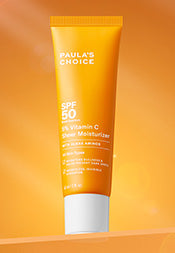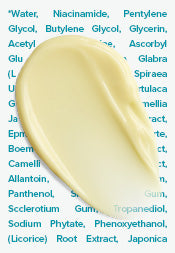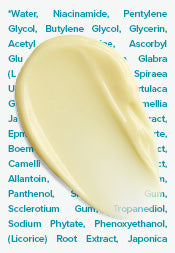Skin Purging vs Acne Breakout
Skin purging is a phenomenon that some people with breakout-prone skin experience after using a leave-on exfoliant or when they incorporate a new product into their normal skincare routine for the first time. The theory is that such products “purge” the skin from clogs that form and get stuck deep in the pore, pushing them out to the skin’s surface. Seemingly overnight, you see a fresh crop of breakout-like dots and bumps across your skin, but eventually the purging tapers off and you start reaping the good rewards from the product. Some of us may know this process as letting the skin get worse before it gets better. But what’s really going on?
Let’s explore everything you need to know about skin purging with our team at Paula’s Choice.
What causes skin purging?
Skin purging can be caused by using a chemical exfoliant that cleans out and unclogs your pores to speed cell turnover, thus bringing the clog in the pore to the surface faster. A similar purging effect can also be observed with other treatments, such as certain retinoids as a result of how the product triggers the skin cells to move from the lower layers to the surface (1,2).
Salicylic acid (also known as BHA) is the chemical exfoliant most associated with purging because it penetrates into the pores to break apart clumps of skin cells. It also thins sticky oil (sebum) buildup as a means of reducing the size of clogs residing deeper in the skin. Salicylic acid also improves the shape of the pore lining, and once the pore is normalised, the backed-up, smaller clog can come to the surface easily.
During the purging phase, most of these clogs would eventually make their way to the surface as open comedones (blackheads) or closed comedones (whiteheads), otherwise known as non-inflammatory acne. When left untreated, these comedones can lead to more inflamed acne bumps, but worry not: regularly using a blackhead remover like a BHA exfoliant or facial cleanser with salicylic acid has the potential to speed up the process and eliminate the clogs that eventually lead to acne. With continued use, BHA steadily eliminates clogged bumps and helps clear the skin (3).
We also urge you to keep in mind that what you see may not actually be skin purging. For instance, the period in which you may just start on a new product coincides with hormonal changes in your body, resulting in a breakout. This is especially true for women who start using new products around the time of their menstrual cycle when breakouts are more common (4).
How to tell the difference between skin purging and breakouts?
The easiest way to tell the difference between skin purging and routine acne breakouts is by the timing. Acne breakouts shouldn’t worsen when you start on a new product that is supposedsuppose to improve that specific skin condition. On the other hand, skin purging happens the moment your new skincare triggers the reaction of comedones.
Dr. Beth McLellan recommends sticking with a product that is known to cause purging but not breakouts, such as a gentle leave-on exfoliant that contains 1–2% salicylic acid. Over time, the blackheads and bumps should improve; if they don’t, you may need an over-the-counter product for your pimples or see a dermatologist for prescription acne treatment products to add to your normal skincare routine (5).
Does skin purging have to happen?
Skin purging does not happen to everyone —the saying that “your skin has to get worse before it gets better” isn’t universally true. Why purging happens to some people and not others remains a mystery, just like how some people experience comedones and not the red, swollen pimples and papules, which are characteristics of inflammatory acne.
If you experience purging as a reaction to the first time use of a skincare product like a leave-on exfoliant or a retinoid, it can be tempting to stop using them immediately, but don’t. Instead, we encourage you to stick it out for a couple of weeks to get through this phase. Otherwise, you’ll be losing out on all the wonderful benefits these kinds of formulations can provide.
More to the point, what you might see on the skin’s surface likely would’ve shown up eventually, or simply would have remained deep in the pore, keeping it clogged and enlarged, possibly developing into cystic acne over time. So, it’s actually good to see all this movement, despite the initial distress it causes.
What if I’m still breaking out more than usual?
If you’re still breaking out more than usual a couple of weeks after the initial “purge,” consider what other new skincare products have you recently incorporated into your normal routine. Your acne breakout may be worsening due to other factors like hormones, medications, or just as a natural progression of your skin.
Alternatively, if your skin isn’t improving as much as you’d like, or if you’re feeling very distressed about its condition, Dr. McLellan recommends you seek help from a board-certified dermatologist to review your regimen and possibly add prescription-strength medications for the treatment of your acne and breakout.
That said, for some people, it simply comes down to their skin not responding well to certain ingredients, which may result in an unwanted reaction to skincare products. This condition is also known as irritant contact dermatitis. If your skin doesn’t seem to be getting through the adjustment period, you may need to quit using the product in question altogether and seek out alternatives.
See our article on stopping unwanted reactions to skincare products for more info.
Shop our non-irritating, fragrance-free skincare for acne-prone skin.
References for this information:
Dermatologic Therapy, September 2017, pages 293-304
Postepy Dermatologii I Alergologii, August 2019, pages 392-397
Clinical, Cosmetic, and Investigational Dermatology, August 2015, pages 455-461
The Journal of Clinical and Aesthetic Dermatology, January 2017, pages 37-46
Journal of Italian Dermatology and Venereology, December 2020, pages 744–748
Recommended Products
SKIN PERFECTING 2% BHA Liquid Exfoliant
SKIN PERFECTING 2% BHA Lotion
SKIN PERFECTING 2% BHA Gel











